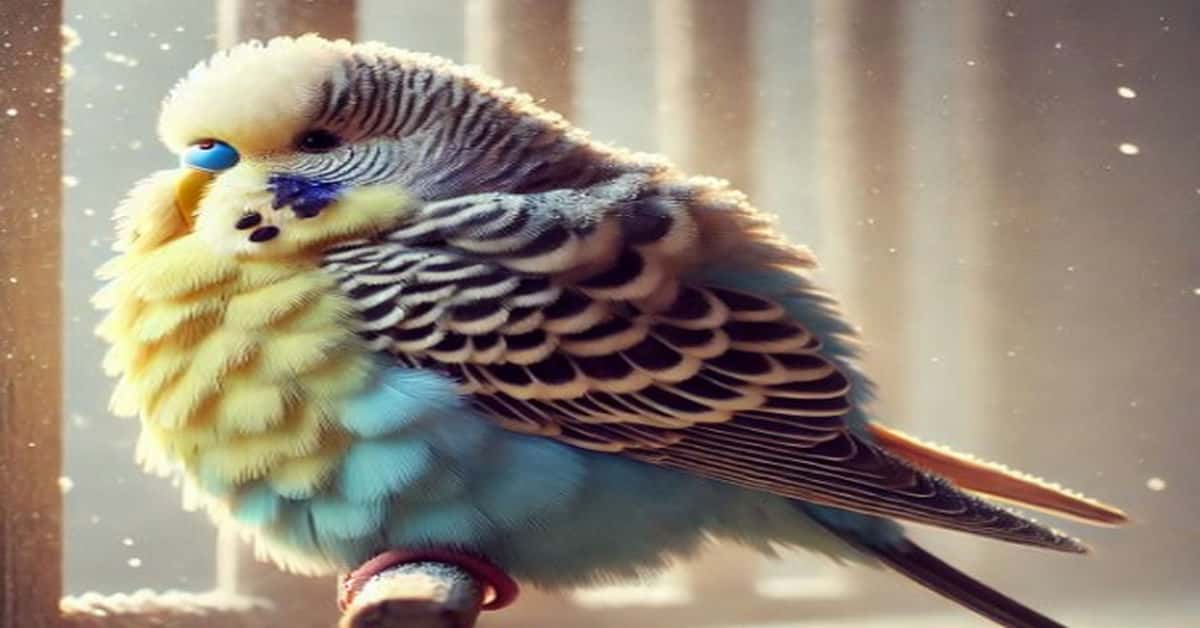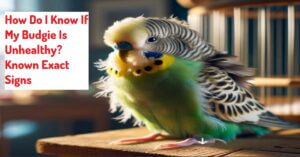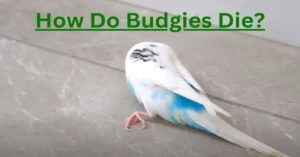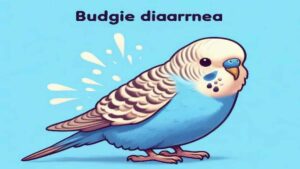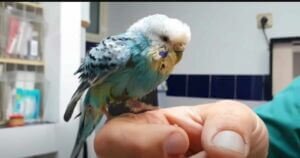Why Do Budgies Puff Up?
Budgies puff up for different reasons, mainly to keep warm, feel comfortable, or relax. Sometimes, they puff up when sleeping, grooming, or even trying to impress a mate.
However, if your budgie is constantly puffed up and appears lethargic, it could be a sign of illness.
Understanding these reasons helps you know when your budgie is just feeling cosy and when it needs attention. This article will explore the reasons behind this behaviour and provide tips on what to look out for.
Why Do Budgies Puff Up?
- Staying Warm: They puff up to trap heat and keep warm.
- Feeling Comfortable: Budgies puff up when they are relaxed and cozy.
- Sleeping: They puff up to conserve energy during sleep.
- Grooming: Puffing up helps them align their feathers while preening.
- Attracting a Mate: They puff up to appear more attractive or dominant.
- Feeling Stressed: Puffing up can be a defense mechanism when scared.
- Illness: Constant puffing may indicate sickness or discomfort.
- Cooling Down: They spread their feathers to release excess body heat.
- Molting: Puffing up makes room for new feathers during molting.
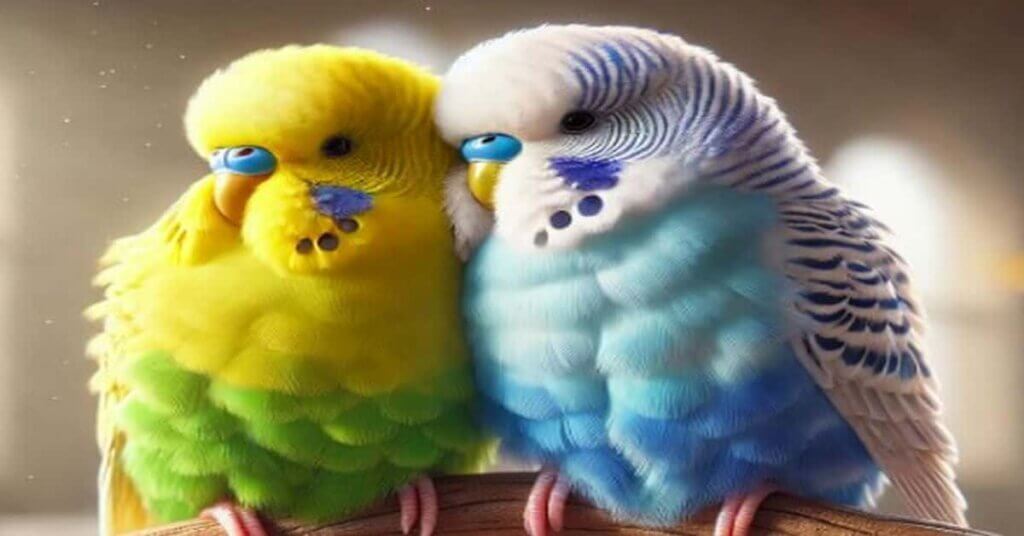
Budgies, like many birds, use their feathers to communicate. Puffing up is their way of sending signals about their feelings and health. But what exactly does it mean when they do this?
Now, let’s check out in-detail budgies’ puffing-up behaviour.
1. Feeling Happy and Comfortable
Budgies also puff up when they feel content and relaxed. If you see your budgie puffed up, eyes half-closed, and comfortably perched, they’re likely just enjoying a moment of peace. It’s their way of feeling cosy, like wrapping up in a blanket.
Observation: Budgies often do this after a nice meal or during a nap. If you see this behaviour, there’s nothing to worry about.
2. Staying Warm
One of the main reasons budgies puff up is to keep warm. When they puff up, birds trap air in their feathers, creating an insulating layer. This helps them retain body heat, especially during winter or colder nights.
Tip: If you notice your budgie puffing up more often, check the room temperature. A temperature between 65°F and 85°F (18°C to 29°C) is ideal for their comfort. If it’s too cold, you can provide a small heater (but not too close!) or cover their cage at night to keep them warm.
3. Feeling Sleepy or Resting
When sleeping, it’s normal for budgies to puff up their feathers. This behavior helps them conserve energy and stay warm. If they’re perched securely, eyes closed, and look relaxed, they’re probably just getting some sleep.
Did You Know? Budgies sleep about 10-12 hours a night, and they can take short naps throughout the day. Puffy feathers during sleep are totally normal.
4. Grooming and Preening
Preening is how budgies keep their feathers clean and well-aligned. Puffing up is part of their grooming routine, allowing them to shake out dust and dirt and align their feathers properly.
Advice: If your budgie puffs up and starts preening, it’s likely part of their natural grooming habit. Regular preening is a good sign of a healthy bird.
5. Trying to Impress or Attract a Mate
Budgies use body language to communicate with each other. They might puff up to appear bigger and stronger when trying to impress a mate or establish dominance. This behaviour is more common during the breeding season.
- Sign to Look For: If you see a budgie puffing up while interacting with another bird, it could be part of their social communication. They may also fan their tails, chirp loudly, or bob their heads.
6. Feeling Stressed or Scared
When a budgie feels threatened or anxious, it may puff up its feathers to make itself look larger and more intimidating. This defensive behaviour is a way of saying, “Stay away!”
If you notice your budgie puffing up along with other signs of stress (e.g., rapid breathing, loud chirping, or pacing), try to find the source of their discomfort. It could be a loud noise, unfamiliar presence, or change in their environment.
7. Signs of Sickness or Discomfort
A budgie constantly puffed up, sitting still, and seeming lethargic or refusing to eat could be ill. Unlike when relaxed or groomed, a sick budgie will often puff up for long periods without other normal behaviours like chirping, playing, or eating.
If the puffed-up state is accompanied by symptoms like watery droppings, weight loss, or changes in behaviour, consult a vet. Illnesses like respiratory infections, parasites, or digestive problems can cause this puffed-up appearance.
8. Keeping Cool
Yes, budgies may puff up to cool down, too. It may seem odd, but puffing up and spreading their feathers allows air to circulate and help release excess heat.
If your budgie puffs up and pants with its wings slightly open, it might be trying to cool down. Make sure it has access to fresh water and shade.
9. Budgie Molting and New Feather Growth
Molting is a natural process where budgies shed old feathers and grow new ones. During this time, they may puff up to make room for new feather growth. The process can make them uncomfortable, making them seem puffier than usual.
Fact: Budgies typically molt once or twice a year, lasting for about 2-3 weeks. It’s normal for them to look a bit scruffy during this period.
How to Tell If Your Budgie’s Puffing Up Is Normal

It’s essential to observe your budgie’s daily habits. A happy, healthy budgie will puff up occasionally, especially when resting or feeling safe.
But, if puffing up is constant and accompanied by other worrying signs, it could mean something more serious.
Signs of Normal Puffing Up:
- Budgie puffs up while napping.
- Briefly fluffs up when grooming or preening.
- Puffs up in the morning stretch.
Signs of Abnormal Puffing Up:
- Constantly puffed up, looking sleepy and inactive.
- Not responding to sounds or movements.
- Changes in eating or drinking habits.
When Should You Be Concerned?

While puffing up is often normal behavior, there are times when it might signal a problem:
- Loss of Appetite or Weight: A sick budgie may not eat properly or lose weight rapidly.
- Constantly Puffed Up: If your budgie stays puffed up for long periods without moving or seems lethargic, it might be sick.
- Changes in Droppings: Watery, discolored, or different-looking droppings can indicate an illness.
Expert Tips for Budgie Care
- Diet: A balanced diet keeps your budgie healthy. Include seeds, fresh fruits, and vegetables. Avoid giving them unhealthy foods, as it can affect their overall well-being.
- Cage Placement: Place the cage in a warm, quiet area. Avoid cold drafts and direct sunlight.
- Regular Checkups: Annual vet checkups help catch any health issues early.
- Grooming: Budgies like to keep their feathers clean. To help with grooming, provide them with a small bowl of bath water or a mist spray.
Frequently Asked Questions And Answers
1. Why does my budgie puff up in the morning?
Budgies often puff up in the morning to stretch, shake off sleep, and prepare for the day. It’s normal, healthy budgie behaviour.
2. Why does my budgie puff up only on one side?
If a budgie puffs up on one side, it might be resting on one leg or trying to keep one side warmer, which is normal behavior.
3. Can budgies puff up due to dehydration?
Yes, dehydration can cause a budgie to puff up and appear lethargic. Make sure your budgie always has access to fresh, clean water.
4. Is puffing up a sign of old age in budgies?
As budgies age, they may puff up more frequently to conserve warmth or due to decreased activity levels. Keep an eye on any changes in behaviour to ensure it’s just age-related.
Final Thoughts: Pay Attention to Your Budgie
Understanding why budgies puff up helps you provide better care for them. Whether they are trying to keep warm, feel comfortable, or display other emotions, noticing the signs will help you identify their needs.
Remember, a puffed-up budgie is not always a cause for concern—it’s just one of their many adorable behaviours. Look for any unusual signs and ensure your feathered friend’s happy, healthy life.
Hello Dear, I'm Poli Kolymnia, owner of many birds (including budgies).
With a deep passion for these feathered companions, I'm here to share my expertise and extensive knowledge on birds care.
My articles cover essential topics like diet, housing, care, and health, providing practical tips to help you create a happy and thriving environment for your birds.

